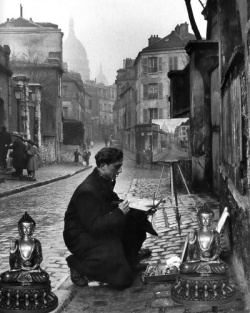Délog
Délog are people who die, enter the bardos, yet miraculously come back to life. Information on délog comes from their own experiences as they relate them upon their return. Their recorded words, called namthar, are powerful teaching tools for religious and lay Tibetans. Geshe Dawa, a teacher at the Library of Tibetan Works and Archives, asserts that karma can only be explained by telling life stories (Public Teaching Lecture, April, 2000). Délog teach the benefits of the dharma and of connections with compassionate teachers, and warn of the dangers of worldly attachments to family, friends, and wealth. They become, in fact, a link between the worlds of the dead and the living. Chagdud Rinpoche describes it this way:
- As a child in Tibet, I sometimes found my mother, Délog Dawa Drolma, surrounded by an audience listening with utmost attention as she told of her journeys to other realms. Her face was radiant as she spoke of the deities in the pure realms; tears flowed as she described the miseries of hell beings and pretas, or tormented spirits. She told of encountering deceased relatives of certain people, and she relayed from the dead to the living concerns about unfinished business (perhaps buried coins or jewels that could not be located) or pleas for prayers and ceremonies [to alleviate the suffering of the hell beings). (Barron and Chagdud, 1995, p. 1)
Chagdud Rinpoche (Ibid., p. xiv) contends: “Some [[[délog]]] appeared to be ordinary lay people, but the experience itself is a sign of great meditative realization, so they could not have been truly ordinary.” And Kyabje Song Rinpoche (1979, p. 20) adds that “Délog are considered holy in my country.”
Since délog are most commonly monks, nuns, or other practitioners, some die during times of spiritual retreat. The délog Lama Jampa Delek was on a retreat in the year 1596, as recorded in his namthar, when he lost his bodily warmth and began to spit bloody phlegm. Knowing he was quite ill, he says, “I performed reverential petitions to A-khu Rinpoche and did meditation. In the retreat I did whatever I could within my experience, but I could not control my body, and the stages of dissolution appeared in succession” (Epstein 1982, p. 42). Shugseb Jetsün Rinpoche (1852-1953) was a famous and accomplished female délog and a practitioner of Nyingma (the oldest tradition of Tibetan Buddhism). According to one biography, after her initial délog experience, she fell ill, died, and returned two more times. She took those opportunities to sharpen her skills in recognizing appearances to be empty (as manifestations of her own mind), therefore preparing herself for liberation from samsara (Yeshi and Tsering, p. 141). Khenpo Sangye Wandü (Interview May 1, 2000) explains that some délog undergo this process of death and return quite often, and usually on auspicious days of the month.
Délog are also able to return to life. Yangsi Rinpoche and Khamtrul Rinpoche (Interviews April 26, 2000 and April 28, 2000) explained that was possible because a subtle form of consciousness remained even after the body and gross consciousness have separated in the process of death. For this to occur, however, the body of a délog must be preserved to allow its consciousness to return. Traditionally, Tibetans were not cremated for at least seven days after death to ensure that the consciousness would not be disturbed as it moved through the bardos. In the namthar of Délog Karma Wangdzin, her relative says, “There are many stories of délog like Lingza Chökyi’s, about those who were carried off and returned. I fervently hope she’ll return as well. We’d best leave her body without touching it during the 49 days” (Epstein 1982, p. 67).
